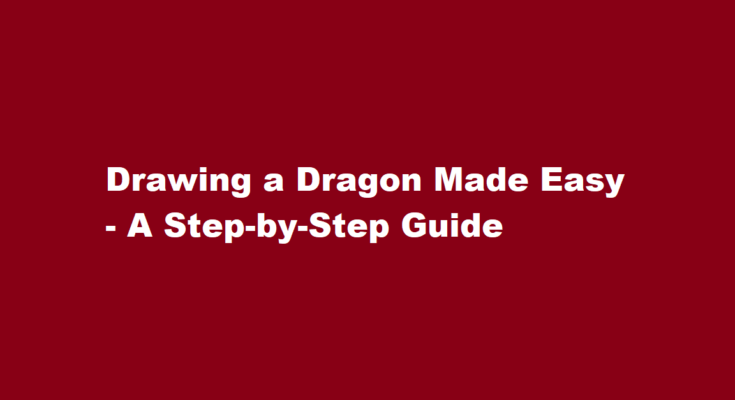Introduction
Dragons have long been a source of fascination and inspiration in art and literature. Their intricate and majestic forms can seem daunting to draw, but with the right approach, you can create your very own dragon masterpiece with ease. In this step-by-step guide, we’ll explore a simple yet effective method to draw a dragon that’s suitable for artists of all levels. Whether you’re a beginner looking to improve your drawing skills or an experienced artist seeking a new challenge, this tutorial will help you bring this mythical creature to life on paper.
Materials
Before we dive into the drawing process, gather the necessary materials. All you need are
1. Paper: Choose a smooth, white sheet of paper.
2. Pencils: Have a range of pencils (2H, HB, 2B, 4B, and 6B) for varying line weights.
3. Eraser: A good quality eraser will help you correct mistakes.
4. Sharpener: Keep your pencils sharp for precision.
5. Reference Images: Find dragon images online or in books for inspiration.
Basic Shapes
Start your dragon drawing by creating basic shapes. Begin with a circle for the dragon’s head and an elongated oval for the body. These shapes will serve as your foundation and help you establish the dragon’s proportions. It’s crucial to get the size and placement right in this initial step, as it will determine the overall appearance of your dragon.
Sketching the Body
Next, sketch the dragon’s body using the basic shapes as a guide. Add curves and lines to create the neck, back, and tail. Dragons often have muscular bodies, so make sure to give it some definition. Experiment with different poses to give your dragon a unique and dynamic appearance. Don’t worry about adding details just yet; focus on getting the overall body structure right.
Head and Facial Features
Now, let’s bring the dragon’s head to life. Start by refining the shape of the head, including the snout and jawline. Add a pair of large, expressive eyes and define the placement of the nostrils. Depending on the style you prefer, you can create various eye shapes and expressions. Experiment with horn placement and the general shape of the head to make your dragon distinctive.
Limbs and Wings
Dragons are known for their powerful limbs and wings. Sketch the legs, claws, and wings on your dragon. Remember to maintain a sense of proportion and symmetry. You can add scales and texture to the limbs and wings later. Ensure that the dragon’s posture and stance match the pose you’ve chosen for the body, making it look balanced and lifelike.
Tail and Details
Extend the tail from the dragon’s body. The tail can be long, coiled, or even spiky, depending on your creative vision. Start adding details to the dragon’s body, such as scales, ridges, and any additional features like horns, spikes, or frills. These details will bring your dragon to life and make it more visually interesting.
Scales and Texture
Now, it’s time to add scales and texture to your dragon’s skin. Begin by drawing small, overlapping shapes across the dragon’s body. These can be in the form of circles, triangles, or any pattern you like. Be patient, as this step requires attention to detail. It’s the scales and texture that will make your dragon look more realistic.
Shading and Depth
To give your dragon depth and dimension, start shading. Pay attention to the light source in your drawing and add shadows accordingly. Use a range of pencils to create a gradient effect, with darker shading in areas that receive less light. Shading not only adds realism but also makes your dragon pop off the page.
Final Touches
Lastly, go over your drawing to refine any lines and add extra details. Erase any unnecessary guidelines and smudges. You can also experiment with colour if you’d like to take your dragon to the next level. Watercolours, coloured pencils, or digital tools can be used to bring your dragon to life with vibrant hues.
FREQUENTLY ASKED QUESTIONS
Are dragons lucky in Japan?
All in all, Japanese dragons are the benefactors and protectors of mankind; powerful and wise guardians that shield us from universal dangers, and impart their wisdom. A symbol of good fortune, they bring us happiness, offering us strength and courage at each important turning point in our lives.
Dragons are lucky in China?
In Chinese culture, the dragon represents good luck, strength, health and also the male element Yang. The dragon is unique because it is the only mythical creature of all the animals in the Chinese zodiac and babies are born in the year of the dragon more than any other animal.
Conclusion
Drawing a dragon may seem daunting, but by breaking the process into manageable steps, it becomes an achievable and enjoyable endeavour. With practice and patience, you can create stunning dragons that captivate the imagination. Remember that each dragon you draw is a unique creation, reflecting your artistic vision and style. So, go ahead, unleash your creativity, and let your dragons soar!
Read Also : A Spectator’s Guide to Watching The Tulsa Kings – More Than Just Basketball



